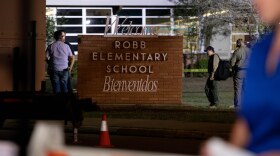After weeks of refusing to speak to the press or community leaders about his actions on the day of a mass shooting at a Uvalde elementary school, district police chief Pete Arredondo broke his silence Thursday and said he didn’t believe he was initially in charge of the situation.
In an exclusive interview with the Texas Tribune, Arredondo, who spoke to the publication on the phone and provided statements through his attorney, also said he left his radio equipment behind because he thought that would save time.
The shooting was one of the worst mass shootings in history and ended with the deaths of 21 people, including 19 children and two teachers.
Arredondo was said to be the incident commander on the scene, according to the Texas Department of Public Safety.
The Texas DPS director, Steve McCraw, said the shooter was inside the school for more than an hour as children called 911 from the classrooms where the shootings took place. Texas Department of Public Safety Director Steve McCraw said there was “no excuse” to make that call.
“With the benefit of hindsight, of course it was not the right decision. It was the wrong decision. There’s no excuse for that,” said McCraw three days after the shooting.
In his interview, Arredondo pushed back against the assertion that much of the blame is his.
“Not a single responding officer ever hesitated, even for a moment, to put themselves at risk to save the children,” Arredondo told The Texas Tribune. “We responded to the information that we had and had to adjust to whatever we faced. Our objective was to save as many lives as we could, and the extraction of the students from the classrooms by all that were involved saved over 500 of our Uvalde students and teachers before we gained access to the shooter and eliminated the threat.”
Arredondo added that while he was in the hallway and the shooter was inside the classroom, he tried several times to unlock the door with dozens of keys he was eventually provided. Not one worked.
It wasn’t until a team of law enforcement officers that included agents of the United States Border Patrol finally were able to breach the classroom that the shooter, identified as 18-year-old Salvador Ramos, was killed.
It was also reported by the New York Times Thursday that law enforcement officers were told there were victims in the two classrooms Ramos entered that needed medical attention, but police instead waited for more protective gear before entering. That is according to video and other material the publication reviewed.
McCraw said days after the shooting that police officers at the scene initially thought the incident had moved from an active shooter scenario to a barricaded subject scenario.
The New York Times reported that, according to a transcript of footage from a body camera, an officer believed to the Arredondo raised concerns over how long the situation was taking.
“We’re trying to preserve the rest of the life,” the officer said.
As the horrific scene continued to unfold, Uvalde police received 911 calls from children and teachers who were inside the classrooms with the gunman. One of the survivors, 11-year-old Miah Cerrillo, told CNN she covered herself in one of her friend’s blood in case the gunman decided to return to where she was.
The weeks-long investigation has also prompted criticism from Katherine Schweit, the creator of the FBI’s active shooter program created after the 2012 shooting at Sandy Hook Elementary School.
“I was shocked. I was shocked. And at first, it was disbelief,” she told NPR on Thursday. “You must pursue all the way to the shooter and neutralize the shooter. That is the lone objective, and that — you should never waver from that.”












